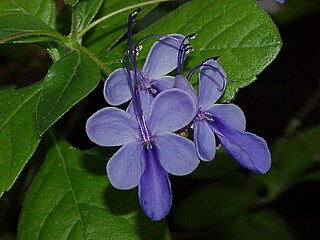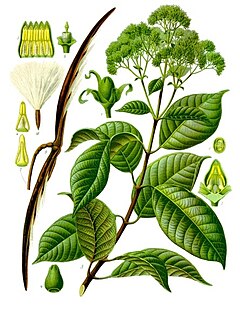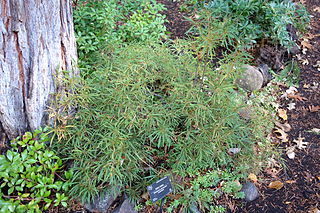
Knightia is a small genus of the family Proteaceae endemic to New Zealand, named in honor of Thomas Andrew Knight. One extant species, K. excelsa (rewarewa) is found in New Zealand. Two further Knightia species are found in New Caledonia, although they were placed in the genus Eucarpha by Lawrie Johnson and Barbara Briggs in their influential 1975 monograph "On the Proteaceae: the evolution and classification of a southern family", a placement supported in a 2006 classification of the Proteaceae. A fossil species from upper Miocene deposits in Kaikorai has been described as Knightia oblonga. Knightia has been placed in the tribe Roupaleae of the subfamily Grevilleoideae.

Dysoxylum is a flowering plant genus of trees and shrubs from the mahogany family, Meliaceae.

Volkameria is a genus of flowering plants in the family Lamiaceae. It is pantropical in distribution. Many of the species are found in coastal habitats.

Willughbeia is a genus of plant in the family Apocynaceae, first described as a genus in 1820. It is native to Southeast Asia with a few species in the Indian Subcontinent. Several species have edible fruits enjoyed in many countries. Many species are vines with sticky latex.
Dendrosenecio brassiciformis is one of the East African giant groundsel, this one is endemic to the slopes of Aberdare Range and bearing fruit but once, and dying after. Once considered to be of the genus Senecio but since have been reclassified into their own genus Dendrosenecio.
Citrus gracilis, the Humpty Doo lime or Kakadu lime, is a straggly shrub endemic to eucalypt savannah woodlands of Northern Territory, Australia.

Rotheca is a genus of flowering plants in the family Lamiaceae. Estimates of the number of species in the genus vary from about 35 to as many as 60. Three of the species are native to tropical Asia, with the rest occurring in Sub-Saharan Africa. The type species for the genus is Rotheca serrata. It had originally been named Rotheca ternifolia, but this name is now considered illegitimate.

Vachellia is a genus of flowering plants in the legume family, Fabaceae, commonly known as thorn trees or acacias. It belongs to the subfamily Mimosoideae. Its species were considered members of genus Acacia until 2009. Vachellia can be distinguished from other acacias by its capitate inflorescences and spinescent stipules. Before discovery of the New World, Europeans in the Mediterranean region were familiar with several species of Vachellia, which they knew as sources of medicine, and had names for them that they inherited from the Greeks and Romans.

Urceola is a plant genus in the family Apocynaceae, first described as a genus in 1798. It is native to China, the Himalayas, Southeast Asia, and New Guinea.
- Urceola brachysepalaHook.f. - Borneo, Java, W Malaysia, Sumatra, Philippines
- Urceola elasticaRoxb. - Borneo, Java, W Malaysia, Sumatra
- Urceola huaitingii(Chun & Tsiang) Mabb. - Guizhou, Guangdong, Guangxi, Hainan
- Urceola javanica(Blume) Boerl. - Borneo, Java, Maluku, Sumatra, Sulawesi, New Guinea
- Urceola laevis(Elmer) Merr. - Palawan, Sabah, Sulawesi
- Urceola lakhimpurensis(S.K.Srivast. & Mehrotra) Karthik. & Moorthy - Assam
- Urceola latifolia(Pierre ex Spire) Mabb. - Laos, Thailand, Vietnam
- Urceola lucida(A.DC.) Benth. ex Kurz - Myanmar, Thailand, W Malaysia, Sumatra
- Urceola malayanaMabb. - Cameron Highlands of W Malaysia
- Urceola micrantha(Wall. ex G.Don) Mabb. - Fujian, Guangdong, Guangxi, Hainan, Sichuan, Taiwan, Tibet, Yunnan, Ryukyu Islands, Assam, Bangladesh, Bhutan, Arunachal Pradesh, Nepal, Cambodia, Laos, Thailand, Vietnam, Myanmar, W Malaysia
- Urceola minutiflora(Pierre) Mabb. - Cambodia, Laos, Thailand, Vietnam
- Urceola napeensis(Quint.) Mabb. - Laos, Thailand, Vietnam, Guangdong, Guangxi
- Urceola quintaretii(Pierre) Mabb. - Laos, Vietnam, Guangdong, Guangxi
- Urceola rosea(Hook. & Arn.) D.J.Middleton - Cambodia, Laos, Thailand, Vietnam, Laos, W Malaysia, Java, Sumatra, Fujian, Guangdong, Guangxi, Guizhou, Hainan, Hunan, Sichuan, Taiwan, Yunnan
- Urceola torulosaHook.f. - W Malaysia, Sumatra, Borneo
- Urceola tournieri(Pierre) Mabb. - Yunnan, Nepal, Bhutan, Assam, Laos, Myanmar, Thailand, Vietnam
- Urceola xylinabariopsoides(Tsiang) Mabb. - Hainan, Vietnam

Hymenodictyeae is a tribe of flowering plants in the family Rubiaceae and contains about 25 species in two genera. The representatives of the genus Hymenodictyon are found in tropical and southern Africa, Madagascar, to tropical Asia and China (Yunnan). The two species of Paracorynanthe are restricted to Madagascar.
Eucarpha is a genus of flowering plant of the family Proteaceae, endemic to New Caledonia. Two species are recognised. Up to 1975, these were classified within the genus Knightia until Lawrence Johnson and Barbara G. Briggs recognised their distinctness, particularly their prominent bracts, in their 1975 monograph "On the Proteaceae: the evolution and classification of a southern family". Nomenclatural combinations for these two species in the genus Eucarpha were published in 2022. Other sources, including Plants of the World Online as of April 2022, treat Eucarpha as a synonym of Knightia.

Chisocheton is a genus of trees in the family Meliaceae. The genus name comes from the Greek schizos and chiton meaning "split tunic", referring to the lobed staminal tube of C. patens. Their range is from India and tropical China, throughout Malesia and south to New South Wales and Vanuatu.

Hymenodictyon parvifolium Oliv. is a small rubiaceous African tree and is one of some 24 species in the genus, with a tropical African and Asian distribution. This species grows as a small tree to some 5 metres tall, or sometimes a liane or scrambler to 10.5 m, and is found in low-altitude woodland.

Rhododendron stenopetalum is a rhododendron species native to southern Honshu and Shikoku, Japan. It is a low shrub, with leaves that are 3–5 mm wide by 5 cm long. Its flowers are pink or lavender-pink.

Reinwardtiodendron is a genus of plants in the family Meliaceae, described by Sijfert Hendrik Koorders and found in south-east Asia. The type species is: R. celebicum Koord.

Clerodendrum chinense, called the glory bower, is a species of flowering plant in the genus Clerodendrum. It is native to Nepal, the eastern Himalayas, Assam, the Andaman and Nicobar Islands, south-central and southeast China, Southeast Asia, and Malesia. A popular garden plant, it has been widely introduced to the rest of the world, including Florida, the Caribbean, Bermuda, Central America, the Galápagos, South America, Ascension Island, the Gulf of Guinea islands, East Africa, the Seychelles, Pakistan, India, the Lesser Sunda Islands, Taiwan, the Cook Islands, Fiji, Niue, and the Society Islands. It has gained the Royal Horticultural Society's Award of Garden Merit. It is a perennial shrub that grows up to 3 metres tall.
TV Berlin is German regional private TV channel for Berlin and Brandenburg. Via the Magenta TV service of Deutsche Telekom, the channel is distributed nationwide.

Wrightia arborea, the woolly dyeing rosebay, is a species of flowering plant in the family Apocynaceae. It is native to the Indian Subcontinent, Southeast Asia, and southern China. A tree reaching 20 m (66 ft), local peoples use it for timber and as the source of a dye.
Eucarpha deplanchei is a species of flowering plant in the family Proteaceae, native to New Caledonia. It was first described in 1865 as Knightia deplanchei, the name used by Plants of the World Online as of April 2022.
Eucarpha strobilina, synonym Knightia strobilina, is a species of flowering plant in the family Proteaceae, native to New Caledonia. Sources vary as to whether they place the species in Eucarpha or Knightia.














